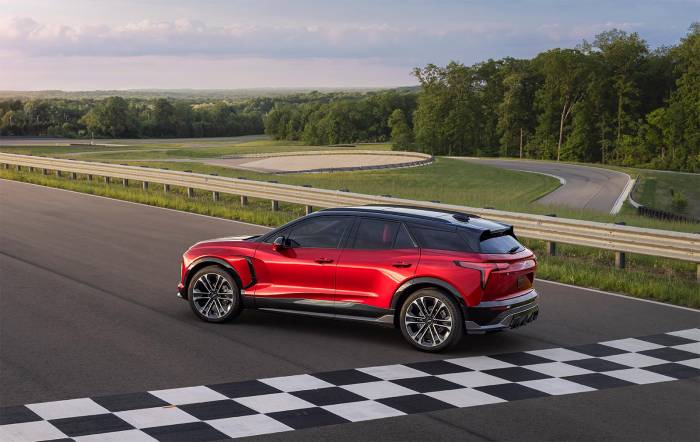Products You May Like
Few automakers have committed more to the transition from internal combustion to all-electric vehicles than General Motors. And it’s rapidly ramping up its product rollout with the debut of the 2024 Chevrolet Blazer EV.
The battery-powered version of the familiar Blazer SUV has some unusual features that, Chevy hopes, will help it appeal to both performance and mainstream buyers.
While it got off to a slow start, GM is rapidly accelerating the rollout of its battery-electric lineup. We’ve gotten to see products as diverse as the big GMC Hummer EV pickup and the Cadillac Lyriq SUV over the last 12 months. Now, the automaker is taking aim at the heart of the automotive market with the debut of the Chevrolet Blazer EV.
If the name is familiar to you, no surprise there — the gas-powered Blazer is one of the most popular models in the midsize SUV market. It’s also no surprise GM decided to retain that badge as it shifts from internal combustion to battery propulsion.

Distinctive Tweaks to a Familiar Design
Indeed, the basic design of the new, all-electric model hews close to that of the existing Blazer. But there are a few immediate clues that this isn’t just an update of the ICE model. As with other battery-electric vehicles, there’s no engine under the hood, so there’s no need for a traditional grille. (On the Blazer, this has largely been replaced with a solid shield to improve aerodynamics.)
But Chevy designers did a good job giving the Blazer’s face a distinctive character, with dart-like headlights that flow into a lightbar that stretches across the front end. With a backlit version of the classic Chevy bowtie logo, the bar does triple-duty, putting on an entertaining light show as you approach. And, when plugged in, it provides an easy way to tell the crossover’s current state of charge.
Viewed in profile, the Blazer EV adopts a subtle sculpting that gives it an upscale look. And with the wheels moved close to the corners, it appears larger than its actual dimensions would suggest.

Ultium Drive
Like the rest of GM’s new BEV family, the 2024 Blazer rides atop the new Ultium architecture, a platform designed specifically for the 30-plus electric vehicles coming to market by mid-decade. It’s a skateboard-style layout that moves the battery pack and motor drive system below the Blazer EV’s load floor.
The Ultium platform is extremely flexible — as it would have to be considering it will handle everything from small passenger cars to big SUVs and pickups. And that proves critical with Blazer EV.
While GM isn’t offering specific details yet, the new Chevy SUV will have at least two battery pack options, including a standard pack offering a reasonable 247 miles per charge, as well as a long-range version that will max out at 320 miles.

A Range of Powertrain Options
What’s particularly unusual is the decision to offer three different motor drive layouts. According to GM, it’s the automaker’s first passenger vehicle ever to give buyers a choice of front-, rear-, or all-wheel drive. But for a handful of commercial vehicles, that appears to be an industry first as well.
There will be four different trim packages, the base 1LT being offered only with the front-wheel-drive arrangement. The high-performance RS, meanwhile, will go all-wheel drive, and the two midlevel packages, the 2LT and RS, will offer buyers an assortment of powertrain options.
Blazer EV SS

The top-trim SS will punch out a full 557 horsepower and 684 pound-feet of torque, noted lead development engineer Bret Dick. And it will add a WOW (“Wide Open Watts”) mode capable of giving a short burst of additional power.
That will be enough to launch from 0 to 60 in “under 4 seconds,” according to Dick, with final numbers yet to be locked down. There will be a trade-off, however, with 290 miles of range from the extended battery pack compared with up to 320 miles from the Blazer RS.
The Blazer EV SS will feature 22-inch summer tires. The 1LT and 2LT will have 19-inch rims and the RS 21-inch wheels. Those three packages will be offered with all-season rubber.
No Frunk, But Extensive Options List
Another trade-off is the lack of a frunk (front trunk). That was the price paid for having the capability of mounting a motor on the front axle, explained Dick.
There’ll be an extensive list of options, including GM’s hands-free Super Cruise system, advanced parking assist, a heads-up display, and a rear camera mirror. All models will come with a broad range of driver-assistance technologies, such as forward collision warning with automatic braking, as well as the ability to download software using smartphone-style, over-the-air updates.
The Blazer EV will feature one-pedal driving, an aggressive form of brake regeneration that allows a motorist to slow (or even stop) the vehicle by modulating the throttle rather than jumping back and forth from the accelerator to the brake.
“Brake regen” captures energy normally lost during braking or coasting and sends it back to the battery, extending range.

Chevy has yet to release charging details, though the numbers are expected to be similar to the Cadillac Lyriq. That means the larger pack could go from a 20% to 80% state-of-charge in roughly half an hour with one of the newer public quick chargers.
2024 Blazer EV: Pricing & Availability
The Blazer 1LT will start at $44,995 and the 2LT at $47,595. The RS will carry a base price of $51,995, and the SS edition will jump to $65,995. (All of these figures include delivery fees.)
Look for the 2LT and RS models to reach showrooms by summer 2023, and the SS is set to launch the following autumn. The launch of the base Blazer EV 1LT hasn’t been locked down, but it’s likely to be late in 2023 or early 2024, according to Chevrolet Marketing Chief Steve Majoros.
“This is the next embodiment of the Ultium platform,” Majoros said during a background briefing near the General Motors Technical Center in Warren, Mich., last week. But the rollout pace will be picking up, he added, with the debut of the smaller Chevrolet Equinox set to follow later this year.

